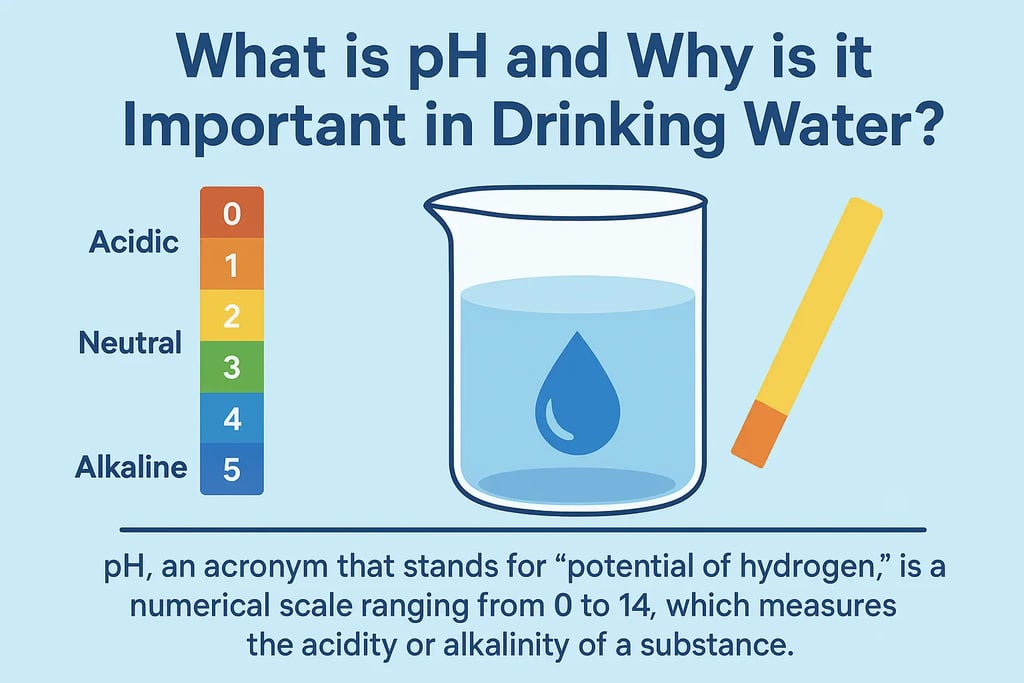What is pH in Drinking Water? Importance, Testing & Health Effects
Learn what pH in drinking water means, why it matters for your health, and how to test and maintain safe pH levels at home. Understand acidity, alkalinity, and water quality factors.


🧪 What is pH and Why is it Important in Drinking Water?
The pH in drinking water is one of the most important indicators of its safety and quality. The term pH stands for “potential of hydrogen”, and it measures how acidic or alkaline a substance is on a scale of 0 to 14.
A pH of 7 is neutral.
Values below 7 indicate acidity.
Values above 7 indicate alkalinity.
Maintaining the right pH level in drinking water is vital because it directly affects health, taste, and water safety.
Why pH Balance in Water Matters
Water that’s too acidic (pH below 6.5) can corrode pipes and leach harmful metals like lead or copper into your drinking water, posing serious health risks. On the other hand, water that’s too alkaline (pH above 8.5) can cause gastrointestinal issues, reduce mineral absorption, and give water an unpleasant taste.
The ideal pH for drinking water ranges between 6.5 and 8.5, as recommended by the World Health Organization (WHO). Water within this range is not only safer to drink but also tastes better, avoiding the metallic or soapy flavors that come with imbalanced pH.
Maintaining optimal pH levels also helps improve water treatment efficiency, protects plumbing systems, and supports aquatic ecosystems.
🌊 Natural Water Sources: How pH Varies in Nature
The pH of natural water sources such as rivers, lakes, and groundwater can vary significantly based on geological and environmental factors.
Factors Influencing Natural Water pH
Mineral Content:
Water that flows through limestone or calcium-rich rocks tends to be more alkaline (higher pH). In contrast, water influenced by volcanic activity or decaying organic matter becomes more acidic.Environmental Conditions:
Rainwater absorbs carbon dioxide (CO₂) from the atmosphere, forming carbonic acid, which can lower the pH of lakes and rivers.
Seasonal changes, temperature fluctuations, and acid rain also alter the water’s natural pH.Human Activities:
Industrial discharges, agricultural runoff, and pollution can introduce acids or bases into natural water systems, disrupting both ecosystems and water quality.
Examples of pH in Natural Waters
Mississippi River: ~6.8 (slightly acidic)
Lake Tahoe: ~7.6 (slightly alkaline)
These examples highlight the need for pH monitoring to protect both human health and the environment.
🧫 How to Test the pH of Your Drinking Water at Home
Regularly testing your drinking water’s pH ensures it remains safe and balanced. You can easily perform this at home using affordable testing kits available online or at hardware stores.
Methods for pH Testing at Home
Litmus Paper / pH Test Strips:
Dip a strip into your water sample.
Compare the resulting color to the chart provided.
Quick and inexpensive for basic checks.
Digital pH Meters:
Offer more accurate readings.
Ideal for repeated testing or ongoing water monitoring.
If your water’s pH is below 6.5, it’s likely acidic and may cause pipe corrosion. Installing a calcite neutralizer, water ionizer, or alkaline filter can help balance it.
If the pH is too high (above 8.5), you can use reverse osmosis systems or pH reducer solutions to correct it.
✅ Tip: Retest your water every few months, especially if you notice changes in taste, odor, or color. Consistent monitoring ensures that your water stays clean, safe, and healthy.
☕ The Role of pH in Beverages: What You Should Know
Just like drinking water, the pH level in beverages affects taste, preservation, and health.
Acidic beverages (pH below 7) have a sharp, tangy flavor and longer shelf life.
Alkaline beverages (pH above 7) taste smoother but may alter body pH if consumed in excess.
Common Beverage pH Levels
Beverage TypeAverage pHNotesSoda2.5 – 3.0Very acidic; can erode tooth enamelFruit Juices (Orange, Cranberry)3.0 – 4.0Tart flavor; natural acidityCoffee4.5 – 5.0Mildly acidicMilk6.5 – 6.8Slightly acidic, near neutralHerbal Tea / Infused Water6.5 – 7.5Healthier, balanced choice
Drinking highly acidic beverages frequently can contribute to dental erosion, digestive discomfort, and acid reflux. For better health, opt for drinks with pH near 7, such as filtered water, green tea, or fruit-infused water.
✅ Key Takeaway: Why Monitoring Water pH Matters
Understanding and maintaining the pH in drinking water is vital for:
Safe and clean water consumption
Improved taste and freshness
Protection against metal contamination
Healthy digestion and mineral absorption
By testing and adjusting your water’s pH regularly, you can safeguard both your health and your home’s plumbing system—ensuring every sip you take is clean, balanced, and refreshing.
